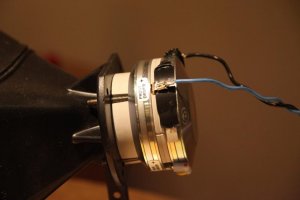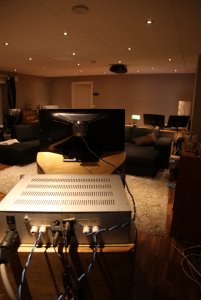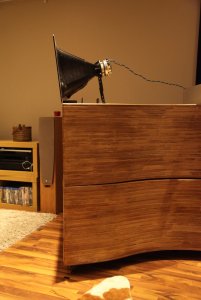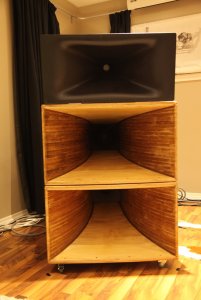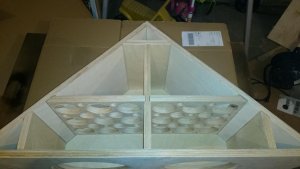OMF's anlegg!
- Trådstarter OMF
- Startdato
Diskusjonstråd Se tråd i gallerivisning
-
Hei!Samme i mine horn. 10dB ned på midbasser i forhold til topphorna. Da med minimal EQ på FLH. Har forsterker med mer gain på midbass en på topphorna.
Hvordan er forsterkere fordelt hos deg?
Skulle gjerne fått justért ned gain på midbass-forsterkeren min til å matche toppene, men gjör det nå digitalt.
Jeg har bygde for en tid tilbake disse monoblokkene som har 3 x Ncore i hver. Så de bruker jeg nå 1 stk på hvert hornstack. Også har jeg en Crown Itech 6000 i boden som jeg bruker til hjørnebassene.
På sikt så ser jeg jeg også etter en løsning på gain, men det kommer nok til å ta litt tid. Nå er det jo slik at Audiolense filteret hos meg kjører all XO og korreksjon, og det filteret har maks 0dB. Så topp og bunn hos meg "toucher" opp i mot 0dB ved enkelte frekvensen, mens midbassen ligger rundt minus 10-15dB.
I tillegg har jeg satt utgangen på Aurora til -10db istedenfor + 4dB. (usikker på hvordan det påvirker signal/støy). Crown har også mulighete til å justere gain. Og med det oppsettet, så spiller jeg omtrent så høyt jeg har planer om å gjøre når lyden i Jriver og Lynx mixeren begge er satt til maks!
Mvh
OMFHøres tøft ut. Jeg vet at D2 og CD horn ikke har noe i mot å få rikelig med forsterkerkraft. Har testet ut D2 med både 300B (9W) og Anaview AMS (180W) og Anaview låter betydelig tøffere og mer dynamisk.
Har du koblet D2 i serie eller parallell? Kan være litt kilen på støy fra kilden i parallellkobling. Derfor er det en attenueringskrets i JBL M2 monitoren som er lagt opp med Itech 1000w på kompresjonsdriveren.De står vel i serie så vidt jeg kan forstå!
Hvor lavt kan/bør D2 spiller i dette hornet....og hvor dypt kan jeg tørre å kjøre måling på det (Audiolense skal gjerne kjøre målesveipet et stykke under delefrekvensen..?
Mvh
OMFHvis det er den originale jumperen som er mellom terminalene, er den koblet i serie. Du har da en impedanse på 32 ohm. Antageligvis ikke noe problem for ncore, men du får ikke full pepper ut. Regner med de spiller höyt nok okke som.
Kobler du membranene i parallell får du impedanse på 8 ohm, betydelig höyere lydtrykk, og muligens mer stöy, avhengig av ncore og lydkortet ditt. Jeg hadde de parallellkoblet og det var tyst hos meg med DLCP og 20dB gain på forsterker, men suste litt med 28dB. Ser du at du trenger massiv korreksjon av D2 for frekvensgang oppover mot 20k (som den er god for), kan det være at du trenger å parallellkoble for å matche gain på midbasshorna. Du demper jo de 10dB allerede?
Har ikke fiklet med dette hornet (bare en liten lytt), men det er godt for 600hz med storformatsdriver. D2 deles på 800hz i M2. Du introduserer mer forvrengning jo dypere du presser den. 700hz nå? Du får pröve deg frem og lytte med örene, evt gjöre forvrengningsmålinger av driver og hornkomboen. Tror nok 600 og lavere er der hvor midbasshorna liker seg best.
Angående måling, så hadde jeg ikke vært redd for å kjöre sveip på relativt höyt volum med bratt höypass på 300hz eller lavere. Driveren er jo konstruert for å tåle masse effekt.Sist redigert:Takk for info!
Har vel i grunn mer enn nok pulver allerede i toppen! Skal se om jeg kan ta en dB måling i morgne så jeg vet omtrent hvor høyt jeg spiller/kan spille!
Hadde forøvrig en veldig god opplevelse i går kveld. Jeg er en litt urolig type, og når jeg nå har jobbet/ventet på et skikkelig system i noen år nå, så har jeg vært veldig utålmodig når jeg endelig kan spille musikk, og jeg har blitt sittende litt og hoppe fra det ene demosporet til det andre....spilt litt for høyt, og ikke blitt dratt skikkelig inn i musikken som er det jeg søker etter.....
Men i går etter å ha sett en episode av House of Cards så spilte jeg musikk med samboeren. Jeg satt i sweetspot, og hun lå i sofaen ved siden av med ipaden(fjernkontroll), og når jeg ikke lengre hadde kontrollen over hva som skulle spilles - så var det mye lettere å slappe av og gli inn i musikken....
Og for meg som alltid har vært veldig opptatt av holografi, presisjon og oppløsning, så kan jeg melde at systemet i kjelleren nå ikke står noe tilbake for mine tidligere oppsett på dette området. Spesiellt er nok oppløsningen bedre og rommet er større...også mangler det muligens litt på presisjon.....Men for meg er det en stor lettelse at disse egenskapene er på plass. (Jeg har ikke hørt mange hornsystemer før, men ofte er jo horneierne veldig opptatt av PRAT og systemene er sjelden spisset mot sort bakgrunn, holografi, presisjon)
Mvh
OMF
Ikke udelt enig i dette, de gode systemene gjør disse tingene bedre enn det meste faktisk. Men en ferdighøyttaler med en enslig plastikktut f.eks. er pr. definisjon egentlig ikke et hornsystem, så det kommer jo an på hva du har hørt! En typisk myte det der. Dessverre.Men for meg er det en stor lettelse at disse egenskapene er på plass. (Jeg har ikke hørt mange hornsystemer før, men ofte er jo horneierne veldig opptatt av PRAT og systemene er sjelden spisset mot sort bakgrunn, holografi, presisjon)88x12_TOM
Gjest
Holografi er et vidtomspennende begrep. Hjelper veldig lite med holografi når det ikke høres troverdig ut. Hørt mange oppsett med såkalt god holgrafi som i mine ører høres meget unaturlig ut. Med god kontroll på førsterefleksjoner og en god impuls/ frekvensrespons, så kommer en naturlig scene fram.
Ps: Hva mener du med PRAT, er det rett og slett det det står, eller er det en forkortelse på noe...Prat er vel et uttrykk som stadig dukker opp i Naim sammenheng.
Pace, Rhythm and Timing.
http://www.tnt-audio.com/edcorner/prat_e.htmlSist redigert:
Damn rigth, Achtmal. De fleste blingriggene er"gode" på s.k. holografi etc. men faller helt sammen på andre og for deg og meg viktigere egenskaper.Holografi er et vidtomspennende begrep. Hjelper veldig lite med holografi når det ikke høres troverdig ut. Hørt mange oppsett med såkalt god holgrafi som i mine ører høres meget unaturlig ut. Med god kontroll på førsterefleksjoner og en god impuls/ frekvensrespons, så kommer en naturlig scene fram.
Ps: Hva mener du med PRAT, er det rett og slett det det står, eller er det en forkortelse på noe...88x12_TOM
Gjest
Over 20db forskjell på korreksjonsfilteret. Har du noe gain problemer eller er det bare så stor forskjell på følsomheten på de forskjellige driverne? Hva bruker du av innstillinger i Audiolense?
Vis meg et eller flere skikkelig hornsystemer som er gode på holografi inkludert dybde
Ikke udelt enig i dette, de gode systemene gjør disse tingene bedre enn det meste faktisk. Men en ferdighøyttaler med en enslig plastikktut f.eks. er pr. definisjon egentlig ikke et hornsystem, så det kommer jo an på hva du har hørt! En typisk myte det der. Dessverre.Men for meg er det en stor lettelse at disse egenskapene er på plass. (Jeg har ikke hørt mange hornsystemer før, men ofte er jo horneierne veldig opptatt av PRAT og systemene er sjelden spisset mot sort bakgrunn, holografi, presisjon)
Det eneste jeg har hørt er ferdighøyttalerene hos Retep, Klipsch RF7 mk1 i et svært bra rom.
Er det en myte?Noen flere bilder....
Mvh
OMFVedlegg
-
318.6 KB Visninger: 500
-
37.5 KB Visninger: 515
-
52.7 KB Visninger: 498
-
264.2 KB Visninger: 514
-
296.5 KB Visninger: 505
-
324.6 KB Visninger: 500
-
306.2 KB Visninger: 526
Forskjellen er såpass stor fra diskanten på topphornet (og dypbassen) til mellombassen.Over 20db forskjell på korreksjonsfilteret. Har du noe gain problemer eller er det bare så stor forskjell på følsomheten på de forskjellige driverne? Hva bruker du av innstillinger i Audiolense?
På den annen side er det såpass mye mer følsomhet i dette systemet, at med LX521 så slet jeg med å spille høyt nok, nå har jeg justert ned gain med 14dB i Aurora, og fortsatt så spiller jeg mer enn høyt nok.
Mvh
OMFSer veldig lekkert ut. Den sofaen din må vel suge enorme mengder bass?
Dette spiller etter min mening veldig bra på holografi. Bredden er veldig bra (naturligvis med så bred lytte-trekant). Dybden er der, men ikke helt ennå. Det er også bra dybdeseparasjon, men sånn artister langt bak frontvegggen har jeg vel bare hørt på rørutstyr...
Vis meg et eller flere skikkelig hornsystemer som er gode på holografi inkludert dybde
Ikke udelt enig i dette, de gode systemene gjør disse tingene bedre enn det meste faktisk. Men en ferdighøyttaler med en enslig plastikktut f.eks. er pr. definisjon egentlig ikke et hornsystem, så det kommer jo an på hva du har hørt! En typisk myte det der. Dessverre.Men for meg er det en stor lettelse at disse egenskapene er på plass. (Jeg har ikke hørt mange hornsystemer før, men ofte er jo horneierne veldig opptatt av PRAT og systemene er sjelden spisset mot sort bakgrunn, holografi, presisjon)
Det eneste jeg har hørt er ferdighøyttalerene hos Retep, Klipsch RF7 mk1 i et svært bra rom.
Er det en myte?
Mvh
OMF
Du eller alle andre som har god dybde i lydbildet, vil jeg gjerne høre om!
Dette spiller etter min mening veldig bra på holografi. Bredden er veldig bra (naturligvis med så bred lytte-trekant). Dybden er der, men ikke helt ennå. Det er også bra dybdeseparasjon, men sånn artister langt bak frontvegggen har jeg vel bare hørt på rørutstyr...
Vis meg et eller flere skikkelig hornsystemer som er gode på holografi inkludert dybde
Ikke udelt enig i dette, de gode systemene gjør disse tingene bedre enn det meste faktisk. Men en ferdighøyttaler med en enslig plastikktut f.eks. er pr. definisjon egentlig ikke et hornsystem, så det kommer jo an på hva du har hørt! En typisk myte det der. Dessverre.Men for meg er det en stor lettelse at disse egenskapene er på plass. (Jeg har ikke hørt mange hornsystemer før, men ofte er jo horneierne veldig opptatt av PRAT og systemene er sjelden spisset mot sort bakgrunn, holografi, presisjon)
Det eneste jeg har hørt er ferdighøyttalerene hos Retep, Klipsch RF7 mk1 i et svært bra rom.
Er det en myte?
Mvh
OMFHøre om.....det er vel bedre å høre på! ;-)
Jeg har begrenset erfaring med å lytte på hornsystemer, og litt "tabloid" så er hovedinntrykket av de systemene jeg har hørt at lydbildet gjerne fremstår som en stor ball foran høyttalerne - gjerne med masse luft rundt. Det er lett å la seg engasjere av et slikt lydbilde og man får lett fot av en jazztrio som står på gulvet en meter foran høyttalerne og jager på!
Mitt oppsett nå spiller omtrent som mine tidligere systemer. Lydbildet er veldig bredt og helt flytende fra høyre til venstre - altså det er ikke slik at lyden enten kommer fra høyre, venstre eller midten...artistene står på ulike plasser på ulike innspillinger! Dybde er litt vanskeligere å beskrive - men det meste skjer mellom høyttalerne, og det er mer slik at tørre/komprimerte kilder kommer frem i lydbildet og de med mye klang legger seg bak. Jeg synes dette gir et riktig lydbilde og savner ikke noe på "dybdrefronten" selv om jeg har hørt systemer som tegner lydbilder som strekker seg langt bak høyttalerne.
Mvh
OMF88x12_TOM
Gjest
Jeg er klar for å jekke deg opp, bare si i fra en dag du har satt av mange timer til hifi og Audiolense kalibrering så kommer jeg ramlende ned på tunet i fallskjerm.Hei!
Takk for oppmuntringer! ;-)
Satsingen har vel i grunn ikke vært så veldig gutsy, det har jo vært noen i kulissene her også. Grelv har vært utrolig hjelpsom og kommet med presise og forklarende svar på alt en amatør kunne finne på å spørre. Også har jeg jo smuglest voksenlektyre her på forumet fra Sluket, LMC, Tytte, Orso, Johoo, ++++.
Men jeg er uansett veldig lettet nå....jeg var vel i grunn aldri så bekymret for at det ikke skulle spille bra, men jeg var litt usikker på om det skulle spille slik jeg ville.....
Men med "My Heart Belongs To Daddy" fra albument under - så tror jeg faktisk jeg slår fast at jeg er på riktig vei...og jeg er ganske nærme mållinjen! Lydhukommelse er dårlige greier, men jeg tror at dette er noe av den beste holografien jeg har hørt.....
Stor lettelse også at det er tyst!
Mvh
OMF - Happy and horny!
For lytting er døren stort sett åpen, men for mer tekniske/målessige sessions - så må jeg oppdatere meg på software...første og fremst å få REW til å spille/måle gjennom JRiver. Slik at jeg kan gjøre målingene med filteret innkoblet - og at man kan se hvordan forskjellige filter slår ut i feks vannfallet!Jeg er klar for å jekke deg opp, bare si i fra en dag du har satt av mange timer til hifi og Audiolense kalibrering så kommer jeg ramlende ned på tunet i fallskjerm.
Mvh
OMF
Om du får til å måle med REW gjennom JRiver/Audiolense er jeg veldig interessert i fremgangsmåte.
For lytting er døren stort sett åpen, men for mer tekniske/målessige sessions - så må jeg oppdatere meg på software...første og fremst å få REW til å spille/måle gjennom JRiver. Slik at jeg kan gjøre målingene med filteret innkoblet - og at man kan se hvordan forskjellige filter slår ut i feks vannfallet!Jeg er klar for å jekke deg opp, bare si i fra en dag du har satt av mange timer til hifi og Audiolense kalibrering så kommer jeg ramlende ned på tunet i fallskjerm.
Mvh
OMF
Jeg kjører avspilling med filtre på samme måte som deg.
....likevel mistenker jeg at dette blir for vanskelig og komplisert for mitt vedkommende.
Mvh. BHei!
Noen flere bilder av blant annet hjørnkassene...
Mvh
OMF
Vedlegg
-
48.9 KB Visninger: 710
Første måling.....
Har ingen anelse hva jeg holder på med her, men dette er altså målt med Audiolense filteret jeg spiller på nå i loopen. REW ser ut til å måle begge høyttalerne samtidig! glattet med 1/48 tror jeg....
Mvh
OMF
- Ble medlem
- 04.03.2004
- Innlegg
- 8.700
- Antall liker
- 7.011
Bruker denne målingen kun mellom 250 og 4Khz.
Jeg tolker det som at du har et litt livlig rom slik høyttalerene spiller i rommet nå og uten kompensering med target kan det lyde litt lyst spesielt ved 2-4Khz.
I store rom som ditt synes jeg dette ofte kan gi en lettflytende signatur i toppregisteret som kan likne den lyden man hører live, men hvis man har problemer i området 800-4Khz kan en slik decay forsterke problemene og gi en lys og spiss lyd på vanskelige innspillinger.
Legger denne standarden til grunn.
D: Midrange Decay Times
Standards:
• Time taken for sound to decay 60dB (T60) should be between 0.2s and 0.5s from 250Hz
to 4kHz
• T20 and T30 should be +/25%
across the same frequency band using one third octave
smoothed bands.
Single figure T60 measurements cannot do much more in a small room than tell you whether a room is
overly live or overly dead. More useful is to look at how sound decays across the critical midrange
frequency bands from 250Hz to 4kHz and to examine whether the speed of this decay is consistent over
time. There are four different problems that can exist with decay times – they can be too long, too
short, uneven across the frequency spectrum or vary excessively over time.
Overly long decay times can obscure low level detail and the timbre of a voice or instrument in much the
same way as a room with a high noise floor. A room with a long decay times also tends to sound harsh
and brittle and can be an unpleasant place to listen resulting in rapid fatigue. Overly long decay times
are considered those over 0.5s.
Decay times that are too short may not allow a spacious, enveloping soundstage to develop and
therefore can be quite boring places to listen. Overly short decay times are considered those under 0.2s.
Music does not come to life but rather sounds dry and sterile. Of note is the fact that acoustical
diffusors actually yield absorption effects in the process of dispersing energy. This is important as a
space with ample use of an appropriate type of diffusor may have a decay time on the lower range but
not feel dry/sterile (likely just the opposite!). This is a prime example of the nuanced nature of
acoustical control where the “road you take” to a specific measurement result is every bit as important
as the end measurement.
A room that exhibits uneven decay characteristics, where the sound decays much faster at some
frequencies than others can at worst sound noticeably unbalanced with a ‘dull’ treble or ‘bloated’ bass.
Uneven decay is most often caused by furnishings within the room such as thin drapes and carpets that
absorb significantly more energy at treble frequencies (above around 1kHz) than they do at midrange
frequencies. Providing the energy follows the criteria in Section B of this document, it is actually
preferred to retain upper midrange and high frequency energy. Our target here is for T20 and T30 to be
within +/‐25% across the frequency spectrum. Significant changes in decay time from T20 through T60
are also a good indicator of spectrally unbalanced reflected sounds.CCyber
Gjest
Ble kult og maskulint, OMF. Silver-platen til Slettahjell er noe av det bedre jeg har på disk. Take it with me-versjonen er uten konkurranse. Tester også riggens evne til dypbass og tyngde.Takk for innspill AtleT høres riktig ut.
Jeg har "himlingstak" hos meg med Eccofon plater og 15 cm glava oppå og med en variernede luftglippe på 10-20 cm opp til Lecaplankene som danner taket.
Så dette dempelaget på mellom 25 og 40 cm i taket er nok noe av årsaken til dempingen mellom 100 og 1000 Hz.
Pr i dag er det ingen aktustikktiltak i rommet, med unntak av 3 hjørneabsorbenter som er stablet opp og det er mye nakne vegger. Så klappetesten er ganske livlig her!
På relativt kort sikt (under 1 år) så ønsker jeg å lage meg 2 stk relativt tykke DIY absorbenter for å ta siderefleksjonene.
Også ønsker jeg meg diffusjone på bakveggen - som også er helt naken - men det koster jo noen kroner.
Mvh
OMF
Jeg synes "take it with me" får veldig god konkurranse av "My Heart Belongs To Daddy"....Ble kult og maskulint, OMF. Silver-platen til Slettahjell er noe av det bedre jeg har på disk. Take it with me-versjonen er uten konkurranse. Tester også riggens evne til dypbass og tyngde.
Jeg synes fortsatt LX 521 er vanvittig god, men 2 hornladede 12 tommere gjør noe annet i mellombassen enn en enslig åtter i dipol!
Holografien, oppløsnignen og fravær av resonanser/forvrengning/uro er merkbart bedre!
Mvh
OMF
Skal teste litt mer de kommende dagene, men ser ut til at jeg har fått det til å funke nå!Om du får til å måle med REW gjennom JRiver/Audiolense er jeg veldig interessert i fremgangsmåte.
Jeg kjører avspilling med filtre på samme måte som deg.
Mvh. B
JRiver - er "synket" med Auroa med ASIO.
Så når jeg måler med Audiolense - så må jeg slå av Jriver - fordi jeg også bruker Asio driverne i Audiolense.
Men i Windows kontrollpanel har jeg nå satt opp "JRiver VDM" driveren som standard lydkilder også bruker jeg "line in" på lydinngangen på hovedkortet som standard rekord. Regner med at du er kjent med VDM driveren til JRiver.
Så når jeg skal kjøre måling i REW - så flytter jeg bare mikrofonene over på Line in - så funker det! Da spilles testsignalet via VDM driveren, og record hentes inn via linjeinngangen! Også kan jo jeg med Lynx mixeren bare slå av de kanalene jeg vil - så skal prøve å ta nye målinger i kveld med Hlyre/venstre kanal hver for seg!
Mvh
OMFOk, vdm driveren er jeg kjent med.
Blir det slik at jeg bruker line in på pc'ens integrerte lydkort da?
Der har jeg kun mini jack tilkobling, men det ordner seg vel med en ny kabel med mini jack i den ene enden vil jeg tro.
Takk for tips, OMF
Grunnen til at jeg vil REW-måle med Audiolense filtre er at jeg vil se hvordan vannfallet/etterslep ser ut når jeg skal begynne på DIY bass.
Den simulerte frekvensresponsen i Audiolense er vel god nok og viser temmelig riktig graf tror jeg. -
-
Laster inn…
Diskusjonstråd Se tråd i gallerivisning
-
-
Laster inn…






